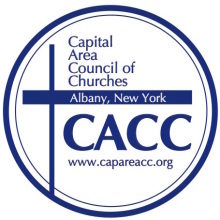The Capital Area Council of Churches (CACC) was founded in 1941 as the Federation of Churches of Christ in Albany, N.Y. and Vicinity. The name was changed to the CACC as part of the adoption of a new organizational constitution submitted for approval to the Annual Meeting in June 1958.
The preliminary considerations for forming this organization had been discussed among four Albany area clergymen: the Rev. William H. McConaghy of the Madison Avenue Presbyterian Church, the Rev. Erville Maynard of St. Peter’s Episcopal Church, the Rev. Arthur Adams of the First Presbyterian Church and Dr. Kenneth B. Wells of the Westminster Presbyterian Church. These discussions culminated in a meeting of area congregation representatives on April 4, 1941 when a “meeting of Clergy and Laity” was held “to consider a proposal for the establishment of a City Federation of Churches in Albany, N.Y.” The first meeting was chaired by the Rev. M. Stephen James who summarized earlier, efforts to organize and credited Mr. Benton S. Hoit with the exploratory work of a draft constitution. Three of these organizational meetings were held in 1941 resulting in the official incorporation of the Federation of Churches of Christ in Albany, New York, and Vicinity on January 12, 1942.
The Federation was intended to encompass, absorb, coordinate and extend the community service and ministry functions of several existing organizations including the Albany Protestant Welfare Society (House of Friendship), the Albany City Council of Religious Education, the State College Christian Association, the Federation of Youth, and the Ministerial Association. These organizations continued to operate under their own names, but were brought to varying degrees under the organizational and financial umbrella of the Federation. Later additional affiliations included: the Council of Church Women of Albany in January 1944; Chapel House (Albany Collegiate Interfaith Center) on December 16, 1966, and the Seaman’s Agency of Albany (the Port Ministry) in 1978.
As stated in its Constitution of 1948, “The particular objects for which this organization is formed are to develop the spirit of christian fellowship and to promote through cooperative effort the spiritual, moral, social and civic welfare of the community.” Rewording in later revisions elaborates and specifies. The CACC administration currently consists of four officers: President, Vice-President, Recording Secretary and Treasurer and a Council Assembly consisting of the clergy and two lay persons from each member congregation (previously there were additional representatives for those congregations larger than a certain size), and the director and two members of other member organizations. They are governed by a Board of Directors consisting of the four officers, committee chairs and a maximum of twelve members-at-large chosen from local laity and clergy of member congregations. Earlier constitutions included one member of each communion in place of the members-at-large. Operational responsibilities are handled by an Executive Committee consisting of the four officers (previously including division chairs and department chairs) with daily administrative responsibilities residing with an Executive Director hired by the Executive Committee.
As of the date of transition from the Federation to the Council in 1958, during the presidency of Dr. Carlyle Adams, the organization consisted of divisions based on geographic proximity; and departments which acted as administrative units or as liaisons to the semi-autonomous organizations which provide services to the community under joint auspices. These were separated into: Program Departments of Community Ministry, Hospital Ministry, Student Work, Christian Education, Social Education and Action, and Evangelism; General Departments of United Church Women, United Church Men, and Ministers’ Association; and Central Departments such as Business and Finance and Public Relations. Current structure provides for standing committees which include the Executive Committee, Nominating Committee, Finance Committee and the Personnel Committee. Previously existing geographic divisions are not specified as of the 1980 Revised Constitution.
Presidents:
1941-1942 Mr. Winthrop P. Stevens
1942-1943 Rev. Brewer Burnett
1943-1945 Rev. William McConaghy
1945-1947 Rev. Hobart F. Goewey
1947-1949 Rev. Arthur M. Adams
1949-1950 Rev. Erville B. Maynard
1950-1952 Rev. Arthur F. Jennings
1952-1954 Rev. Dr. Russell G. Ganzele
1954-1956 Rev. Ross Blake
1956-1958 Mr. Russel H. Broughton
1958-1960 Rev. Dr. Carlyle Adams
1960-1961 Rev. Harold Griffis
1961-1963 Rev. Dr. LeRoy C. Brandt
1963-1965 Dr. Milton C. Olson
1965-1966 Rev. Dr. Norman E. Thomas
1966-1968 Rev. Ralph M. Carmichael
1968-1969 Rev. W. Bernard Grossamn
1969-1970 Rev. Dr. Robert C. Lamar
1970-1972 Rev. Ralph H. Elliot
1972-1973 Rev. Louis Brewer
1973-1975 Rev. Robert B. Thomas
1975-1977 Rev. Bruce Miller
1977-1979 Rev. Ricahrd B. Hunter
1979-1982 Rev. Craig Bartholomew
1982-1984 Rev. William Roland
1984-1986 Mr. Joseph Lynn, Jr.
1986-1988 Hon. Morton M. Z. Lynn
1988-1991 Mrs. Evelyn C. Stone
1991-1993 Rev. Dr. S. Albert Newman
1993-1995 Rev. Fred Shilling
1995-1997 Rev. Allan Janssen
1997-1997 Rev. Edgar N. Kemp, Jr.
1997-1999 Marlene Shilling
2000-2001 Harold R. Howes
2001-2004 Rev. William Cotant
2004-2007 Rev. Vernon Victorson
2007-2009 Joan A. Lipscomb
2009-2011 Rev. Paul Rees-Rorhbacher
2011-2014 Deb Riitano
2014-2015 George Herrick
2016-2019 Rev. Dr. Judith Johnson-Siebold
2019-Present Magaret Danes
Vice-Presidents:
2017-2019 Peter Fish
2019-Present David Stagliano
Executive Directors:
Richard Morford
Harvey W. Hollis
Richard Norman Hughes
Vladimir Hartman
Joyce Steinkraus Giles
James H. Snedeker, Jr., Interim
Fred Shilling
James H. Snedeker, Jr., Interim
Edgar N. Kemp, Jr.
Robert C. Lamar
John U. Miller
Rev. George Brennan
Rev. Vernon Victorson
Deb Riitano
Bruce France
